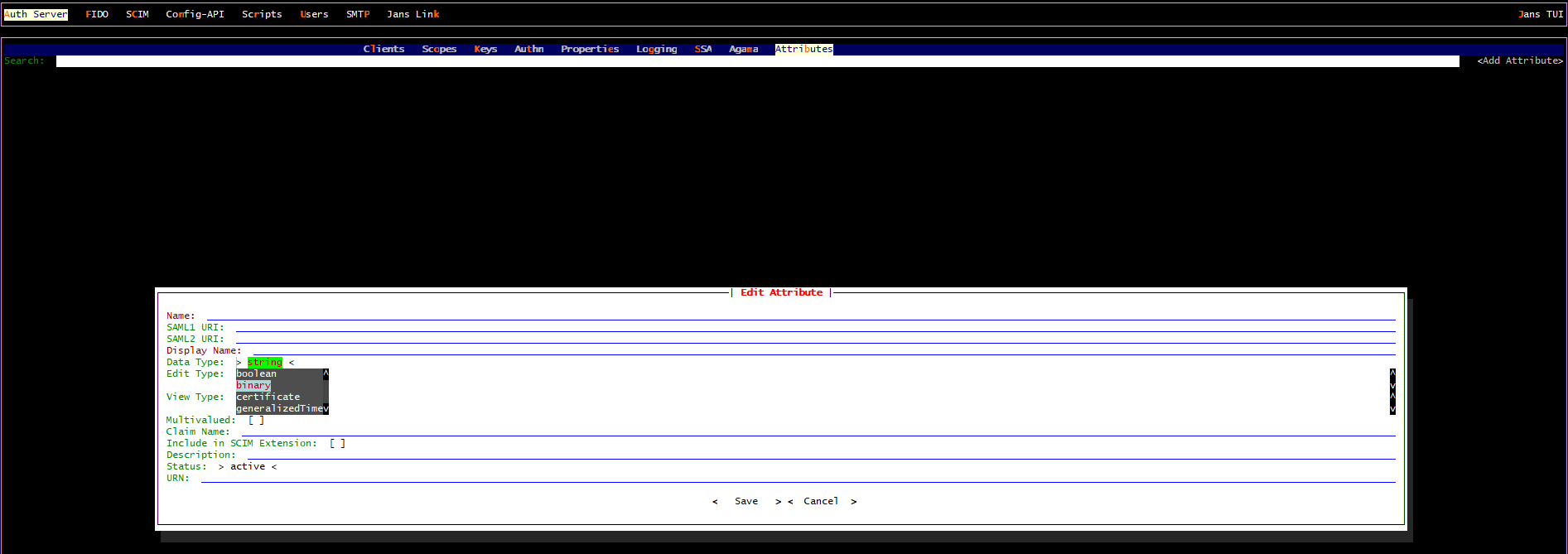Custom Claims#
Custom claims provide the flexibility to include application-specific or user-specific information in the authentication process.Custom claims serve to enrich the information available to the relying party (RP), which is the application or service that relies on the identity provided by the OIDC provider. While standard claims provide basic user information, custom claims allow for the inclusion of domain-specific attributes or application-specific data that might be required for user personalization, authorization, or other business logic. User claims should be unique and non-null or empty.
Adding a new custom user claim#
LDAP persistence#
Step 1: Create a custom attribute#
Create a new custom attribute using Test User Interface or CURL commands, superb tools provided in Janssen. The attribute name should be the claim name.

Step 2: Make entry of the claim in OpenDJ Schema#
- In OpenDJ, add custom attributes in
/opt/opendj/config/schema/77-customAttributes.ldif. In the below example,newClaimis our custom attribute.
dn: cn=schema
objectClass: top
objectClass: ldapSubentry
objectClass: subschema
cn: schema
attributeTypes: ( 1.3.6.1.4.1.48710.1.3.297 NAME 'newClaim'
DESC 'New claim'
EQUALITY caseIgnoreMatch
SUBSTR caseIgnoreSubstringsMatch
SYNTAX 1.3.6.1.4.1.1466.115.121.1.15
X-ORIGIN 'Jans created attribute' )
- Add custom attribute to the jansCustomPerson objectClasses.
objectClasses: ( 1.3.6.1.4.1.48710.1.4.101 NAME 'jansCustomPerson'
SUP ( top )
AUXILIARY
MAY ( newClaim $ telephoneNumber $ mobile $ carLicense $ facsimileTelephoneNumber $ departmentNumber $ employeeType $ cn $ sn $ st $ uid $ givenName $ middleName $ nickname $ manager $ street $ postOfficeBox $ employeeNumber $ preferredDeliveryMethod $ roomNumber $ secretary $ userPassword $ homePostalAddress $ l $ postalCode $ description $ title $ jansStatus $ memberOf $ displayName $ mail $ emailVerified $ jansAdminUIRole )
X-ORIGIN 'Jans - Custom persom objectclass' )
The complete 77-customAttributes.ldif will look like this:
dn: cn=schema
objectClass: top
objectClass: ldapSubentry
objectClass: subschema
cn: schema
attributeTypes: ( 1.3.6.1.4.1.48710.1.3.297 NAME 'newClaim'
DESC 'New claim'
EQUALITY caseIgnoreMatch
SUBSTR caseIgnoreSubstringsMatch
SYNTAX 1.3.6.1.4.1.1466.115.121.1.15
X-ORIGIN 'Jans created attribute' )
objectClasses: ( 1.3.6.1.4.1.48710.1.4.101 NAME 'jansCustomPerson'
SUP ( top )
AUXILIARY
MAY ( newClaim $ telephoneNumber $ mobile $ carLicense $ facsimileTelephoneNumber $ departmentNumber $ employeeType $ cn $ sn $ st $ uid $ givenName $ middleName $ nickname $ manager $ street $ postOfficeBox $ employeeNumber $ preferredDeliveryMethod $ roomNumber $ secretary $ userPassword $ homePostalAddress $ l $ postalCode $ description $ title $ jansStatus $ memberOf $ displayName $ mail $ emailVerified $ jansAdminUIRole )
X-ORIGIN 'Jans - Custom persom objectclass' )
Warning
Spacing is extremely important in the customs attributes file above. There must be 2 spaces before and 1 after every entry (i.e. DESC), or your custom schema will fail to load properly because of a validation error. You cannot have line spaces between attributeTypes: or objectClasses:. This will cause failure in schema. Please check the error logs in /opt/opendj/logs/errors if you are experiencing issues with adding custom schema. This will help guide you on where there may be syntax errors.
Step 3: Restart opendj service.#
Restart the opendj service.
That will create the custom user claim in the local LDAP server.
Once the user claim is added, it can be used in user management.

MySQL persistence#
Step 1: Create a custom attribute#
Create a new custom attribute using Test User Interface or CURL commands, superb tools provided in Janssen. The attribute-name should be the claim-name.

Step 2: Make entry of the claim in MySQL Schema#
- Add a column to table
jansPersonin MySQL. Command will beALTER TABLE jansPerson ADD COLUMN <claimName> <dataType>;
Example
mysql> ALTER TABLE jansPerson ADD COLUMN newClaim VARCHAR(100);
Choose dataType according to the following table
| TUI dataType | SQL dataType |
|---|---|
| Text | VARCHAR() string value to be kept, SIZE is an integer for max string size |
| Numeric | INT |
| Boolean | SMALLINT |
| Binary | BINARY |
| Certificate | TEXT |
| Date | DATETIME(3) |
| Numeric | INT |
| Multivalued | JSON |

Warning
If the attribute is Multivalued, dataType should be JSON regardless of what you will choose for Type in Janssen TUI.
The above steps will create the custom user claim in the MySQL persistence.
Once the user claim is added, it can be used in user management.

Created: 2022-07-21